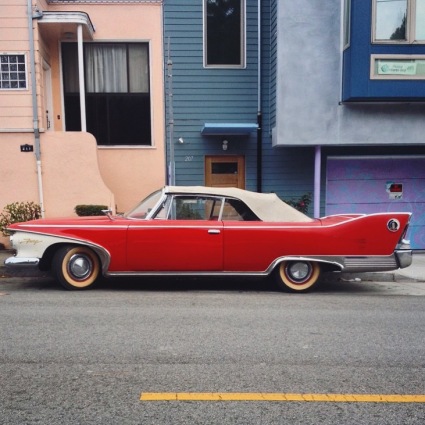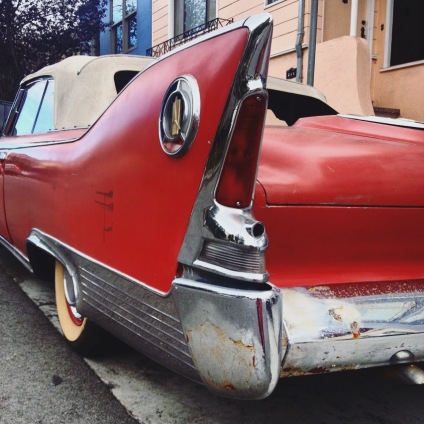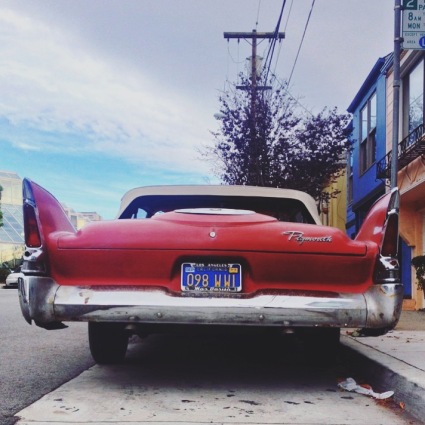 We’ve mused before about the 1960 Plymouth, and the future it found itself in not being as kind as its forebearers had promised it in the Fall of ’56. Plymouth had a hard time moving on from its miserly image in general, with Dodge prominently powerful as a more premium player in the makings of Mopar at the turn of the decade.
We’ve mused before about the 1960 Plymouth, and the future it found itself in not being as kind as its forebearers had promised it in the Fall of ’56. Plymouth had a hard time moving on from its miserly image in general, with Dodge prominently powerful as a more premium player in the makings of Mopar at the turn of the decade.
Nevertheless, Plymouth was to offer a glamorous convertible, as expected by all of the Low-Priced Three as a traditional halo model. 1960 would be no different for Plymouth, as they rivaled Chevrolet for the most flamboyant offering for 1960 for the smallest of open top budgets.
 1960, like most years tying two decades together, spoke to the aesthetic of one era leaving, and another one coming in. Automotive styling pretty much still reflected fifties flamboyant with a gargantuan glob of googie details slathered on for good measure.
1960, like most years tying two decades together, spoke to the aesthetic of one era leaving, and another one coming in. Automotive styling pretty much still reflected fifties flamboyant with a gargantuan glob of googie details slathered on for good measure.
In this case the 1960 Plymouth models weren’t too out of step with what everyone else save the ultra-rationalized compacts from the Big 3 and Studebaker clothed their frames with. Speaking of, this was the first year that Plymouth and all other Mopars save the Imperial went frame-less with Uni-body structures to combat the perception of poor quality that plagued earlier plumage packed Forward Look efforts.
 The stable styling details, especially Plymouth’s use of rather blunt shark fins on their big cars, softened the transition, and hoped to validate what the original beastly beauties offered in an effort to establish styling continuity.
The stable styling details, especially Plymouth’s use of rather blunt shark fins on their big cars, softened the transition, and hoped to validate what the original beastly beauties offered in an effort to establish styling continuity.
Unfortunate for this forward movement in styling, most American buyers were tired of the finned flamboyance, or weren’t convinced highly vertical visual details actually aided in high speed stability, aerodynamics or fuel economy. Both Ford and Chevrolet sent their wings fully horizontal and not offering any blind spots in the over the shoulder view.

The competition for space in the ragtop race was pretty fierce in recession addled 1960 as well. Not only where their open top beauties within a couple of dollars in forms of galloping Impalas and interstellar appearing Galaxies, right below was the compact Lark convertible new for ’60 with V8 verve and compact economy.
Slightly north was the bodyshell sharing Dodge Dart Phoenix convertible, nevermind the Pontiac Catalina and Mercury Monterey convertibles if you wanted a little bit more discreet in your styling details.
 However, if you wanted the cheapest uni-body convertible with a bevy of V8’s, Highland Park’s legendary Torsion-Aire handling, Torqueflite Automatic and Total Contact Brakes, the 1960 Fury fit the bill to all those T’s. The 1960 Plymouth built upon the already stellar reputation that most Mopar offerings had regarding being the closest to true “driver’s cars” compared to other American offerings in the mid-century.
However, if you wanted the cheapest uni-body convertible with a bevy of V8’s, Highland Park’s legendary Torsion-Aire handling, Torqueflite Automatic and Total Contact Brakes, the 1960 Fury fit the bill to all those T’s. The 1960 Plymouth built upon the already stellar reputation that most Mopar offerings had regarding being the closest to true “driver’s cars” compared to other American offerings in the mid-century.
But how did our be-finned baking under the solar rays machine do in 1960? At 7,080 units, the Impala Convertible bought in 10 times as many buyers. It was a tough time to be anyone but Chevrolet in 1960 anyways, as Ford managed just under 45,000 Galaxie convertibles. But nearly 60 years later, we are amazed by the flamboyant Plymouth the most, as a tribute to all things possible in a designers imagination.
The rear end is pretty good looking, just a year or two past its expiration date. Perhaps auto designs need warnings, like milk cartons?
As for the front, it’s unfortunate that so many of these came with the two-tone fenders.
Without that distraction, they really aren’t any weirder than most of the competition.
LikeLike
I’ve noted that a lot of people give the 1960 Plymouth a lot of flack, and I think frankly it’s a more calmed down and refined representation of the Plymouth-Specific Forward look compared to the 1959 models. Like all of the ’59 models, I feel like Mopar mucked up the look by adding Harley Earl levels of chrome, so to my eye, the 1960 models, with the exception of the Dodge, were a nice “re-set” and perhaps the purest models after the fantastically flawed ’57’s.
LikeLike
Reset is a good term for it.
Unfortunately with GM & Ford coming out with more clean sheet designs in 59-60, “suddenly it’s ’57” wasn’t quite competitive.
What drives me nuts about the Exner cars is that almost every one of them has something I think is fabulous, and something I really dislike.
I can come up with several mix & match frankencars that would be quite satisfactory, but I think the ’57 300 is the only one that I wouldn’t want to change something.
LikeLike
I still find it amazing that such outré vehicles were just ordinary folks cars once…
LikeLike
Camp for everyone?
LikeLike
Isn’t that the true and secret goal of civilisation, Laurence?
LikeLike
We’re decidedly failing in the modern era.
LikeLike
If only the ’60 Plymouth had the rear deck of the ’61… Some of Exner’s designs from this period have lovely, smooth sloping rear decks (at least the ones without the fake spare tires on them); imagine how forward looking this car would have been with no fins at all.
LikeLike
I think that’s why I never understood why they didn’t keep basically the same 1960 face for 1961, instead of going for the pinched, angry-furrowed brow look they did choose. The ’61 isn’t that bad from the rear 3 quarters perspective (although I would have integrated the tail lamps differently), but it all falls apart in that face for me. And yeah, without the fake spare trunk imprint, the 1960’s look a lot better.
LikeLike
What another great example of this vintage Plymouth! For the ’61 Plymouth, I sometimes imagined a taillight treatment similar to that of the ’63 Valiant for the ’61 Plymouth… imagine what a difference that would have made.
LikeLike
I meant to add that your photography really captures all the elements of this car well, Laurene.
LikeLike
OMG! I meant LAURENCE, so sorry! My face is as red as the car.
LikeLike